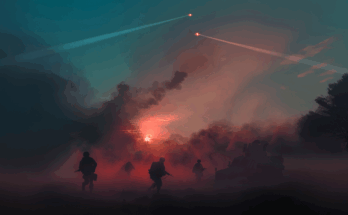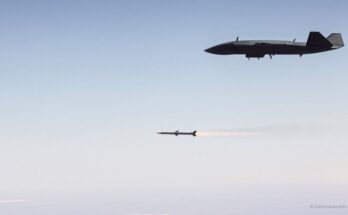In an effort to accelerate its broad military modernization initiative, the government of Poland has reached an agreement with South Korea for the supply of self-propelled howitzers (SPHs), main battle tanks, and light combat aircraft. The massive arms agreement carries an estimated price tag of $14.5 billion – larger than Poland’s entire current-year defense allocation of $14.1 billion. It covers the acquisition of 180 Korean-designed K2 Black Panther tanks, 672 K9 “Thunder” SPHs, and 48 FA-50 Golden Eagle light fighters.
According to reports, the Polish and South Korean parties are also negotiating a follow-on deal involving the sale of 820 K2 “PL” variants of the South Korean design that will be adapted for Polish requirements. Further down the line ,the two sides would then cooperate on developing a next-generation variant of the K2, the K3PL.
The size and scale of the agreement are surprising to many observers, particularly in that Poland has leaned toward U.S.-sourced hardware when possible. But the South Korean defense industry has spent decades building up its design, engineering and technological prowess and now serves as an increasingly major supplier on the global arms market. Its K9 SPH now sits only behind Germany’s PzH 2000 as one of the most sought-after mobile artillery pieces on the export market.
While Polish defense planners are aware of the historic vulnerability of the country to land attack and wary of the Russian forces situated astride the country’s border in Kaliningrad oblast, the purchase of the South Korean main battle tank comes as a small-scale surprise.
Poland previously had designs on additional purchases of used Leopard main battle tanks from its security partners. Poland acquired surplus Leopard 2A4 and 2A5 variants retired from Germany’s Bundeswehr in separate batch purchases in 2001 and 2013 that are in the process of being upgraded to the 2PL standard by Rheinmetall Defence.
Warsaw had also purchased 250 U.S.-built M1A2 Abrams System Enhancement Program version 3 (SEPv3)-configured main battle tanks via the Pentagon’s government-to-government Foreign Military Sales (FMS) channel. Also on tap is the transfer of another 116 M1A1SA Abrams tanks to Poland that will be upgraded to the M1A2SEPv3 configuration before entry into Polish service around 2023-2024.
The Polish Land Forces previously relied on Soviet-era fleets of T-72 main battle tank, plus an advanced Polish design of the latter, the PT-91 Twardy. But with 240 T-72s, plus a number of PT-91 Twardys, donated by Warsaw to Ukraine to aid in that country’s defense against Russia’s invasion, the need to backfill numbers immediately took on urgency.
Under its longer-term plans to replace its obsolete T-72 and PT-91 tanks, Poland began examining new-generation MBT options under a program called “Wilk,” or Wolf, with initial indicators showing interest in an industrial tie-up with France and Germany in order to partake in the nascent Franco-German new-generation tank project planned by Nexter and Krauss-Maffei Wegmann.
But the Russian invasion of Ukraine upset the normal procurement timelines and shifted priorities. Older Cold War-legacy hardware that Poland had been in the process of slowly weaning its armed forces from now becomes harder to keep in service due to export licensing issues and rapidly dwindling spare parts. The logistical realities and attendant political issues vis-à-vis Russia thrusted rapid decisions on Polish defense planners.
With Poland already having had some earlier discussions with Hyundai Rotem regarding production of 800 K2 tanks, the South Korean option – replete with sought-after localized industrial workshare – took on steam.
Under the current agreement, the first 180 tanks will be delivered from South Korea starting this year, with deliveries wrapping up in 2025. Once in Polish service, these will equip three battalions.
The follow-on agreement for the 820 K2PL tanks would see serial production split between South Korea and a new factory in Poland, with deliveries starting in 2026. These will then equip 14 Polish battalions.
Regarding the K9 SPH deal, the order will supplement Poland’s ongoing acquisition of 96 Krab 155mm SPHs from local manufacturer Huta Stalowa Wola under a December 2016 deal. The Krab SPH is built on a K9 chassis designed by South Korea’s Hanwa Techwin under license, hence the symmetry of the K9 acquisition. The Krab order was to be fulfilled by 2024, but an additional Krab order from Ukraine has pushed final delivery of these out to 2025.
In the meantime, the first tranche of K9 SPHs – the K9A1 – involving 48 units will be built in South Korea and delivered from 2022 through 2023. The second tranche – involving 624 K9PL variants – will be produced in South Korea and at a new factory in Poland, with deliveries beginning in 2024 and 2026, respectively. Following delivery of the second tranche units, the first tranche of K9A1s will be upgraded to the K9PL configuration.
Mirroring the K2 tank deal, development of a Polish-South Korean K9PLA3 (or Krab 2 in Poland) next-generation SPH based on cooperative research will then begin in 2025-2026, with future production undertaken in both Poland and South Korea.
Ok, an update, because this is huge! Informations I will provide below, is from Armaments Agency spokesman Col. Krzysztof Płatek. Polish MoD plans:
MBT's:
– 116 M1A1SA to be upgraded to M1A2SEPv3.
– 250 new built M1A2SEPv3.— Damian Ratka (@DRatka1) July 25, 2022
Finally, there are the 48 FA-50PL training and light combat aircraft. These will replace the Polish Air Force’s obsolete Russian-designed MiG-29 and Su-22 fighters and equip three air squadrons. The first 12 of these will be produced in Block 10 standard and delivered in Poland in mid-2023. The remainder will arrive in Block 20 standard, with deliveries running from 2025 onward. Additionally, Korea Aerospace Industries (KAI) will establish a servicing center in Poland, with the target date to open set for 2026.
Once in service, the FA-50PLs will supplement the Polish Air Force’s 48 F-16C/D Block 52+ fighters and incoming 32 F-35AS.
The FA-50PLs will also serve as trainers and enable pilots to transition through to the F-16, thus reducing training costs. Though Poland purchased the Leonardo M-346 as its preferred lead-in fighter-trainer platform, Defense Minister Mariusz Blaszczak noted that their availability rate remains low; therefore, the FA-50PL provides a necessary complement, enabling more cadets at the Air Force University to undertake training missions.
Poland has also expressed to Seoul interest in the South Korean “4-plus generation” KF-21 Boramae fighter, which conducted its maiden flight on July 19, 2022.
The war in Ukraine raised alarm bells in Poland, a country with a long history of conflict with Russia. The transfer of surplus and outdated weaponry to Ukrainian forces then created a capacity gap requiring urgent backfilling.
For Poland, intent on never again suffering what the country did in the Second World War when it was invaded simultaneously by Nazi Germany and the Soviet Union and then subjugated by both, the long-procurement timelines of many of its NATO allies made little sense. Years and years of preparing tenders, examining bids, and finding the perfect match between industrial workshare and capability requirements made little sense under the current environment.
Newly written amendments to its budgetary law – the Act on Homeland Defense adopted on February 23, 2022 – setting a requirement that future annual defense budgets meet 2.5 percent of GDP by 2026 will enable Warsaw to undertake a more rapid and aggressive procurement approach to its already-ambitious modernization plan. Further upticks to the topline defense budget – up to 3 percent of GDP – are expected via an amendment to the Act on Homeland Defense.
For Poland, waiting another decade to formulate and execute its modernization ambitions was no longer an option. After Russian armor began rolling into Ukraine on February 24, the future became now.
Dan Darling is Forecast International’s director of military and defense markets. In this role, Dan oversees a team of analysts tasked with covering everything from budgeting to weapons systems to defense electronics and military aerospace. Additionally, for over 17 years Dan has, at various times, authored the International Military Markets reports for Europe, Eurasia, the Middle East and the Asia-Pacific region.
Dan's work has been cited in Defense News, Real Clear Defense, Asian Military Review, Al Jazeera, and Financial Express, among others, and he has also contributed commentary to The Diplomat, The National Interest and World Politics Review. He has been quoted in Arabian Business, the Financial Times, Flight International, The New York Times, Bloomberg and National Defense Magazine.
In addition, Dan has made guest appearances on the online radio show Midrats and on The Media Line, as well as The Red Line Podcast, plus media appearances on France 24 and World Is One News (WION).



